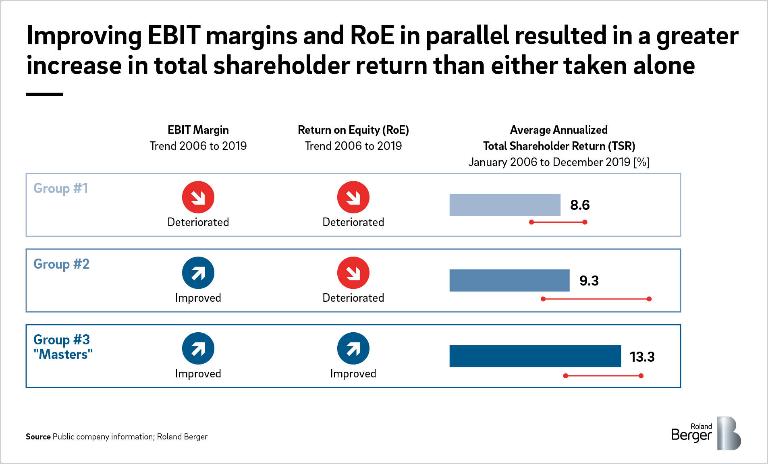

The case for capital efficient strategies
Why industrial multi-business corporations need to pursue both margin improvement and capital efficiency
By Urs Neumair, Gerald Orendi and Sven Siepen
There is a widely held belief that conglomerates are not liked by capital markets. But in our study of 21 industrial multi-business corporations, we found that investors did in fact appreciate the improvement of already good double-digit EBIT margins over the past 14 years. However, an even bigger success on the capital markets can be achieved when these corporations pursue the goal of improving both EBIT margins and capital efficiency.
"The ever-recurring talks about the demise of multi-business corporations might be premature."
Today’s large corporations have little in common with those of days gone by. Gone are the complex, archaically structured conglomerates with fingers in multiple pies, replaced by streamlined, vibrant multi-business corporations. Yet capital markets are still not convinced – analysts tend to punish their businesses with a ‘conglomerate discount’ due to perceived problems with decision-making and resource allocation.
However, our study of 21 industrial multi-business corporations (11 European, including Siemens, Alstom and Danfoss; 10 US, including Caterpillar, Honeywell and ITW) finds that, on average, they improved their already strong double-digit EBIT margins by 2.7 per cent between 2005 and 2019. Shareholders have reaped the benefits, with the 21 companies realizing an annual total shareholder return (TSR) of 10.7 per cent per annum between 2006 and 2019. Even when the dates are extended to include the beginning of the coronavirus crisis the TSR is 8.3 per cent.
"Capital markets love corporations that pay as much attention to capital efficiency as to EBIT margin improvement."
While impressive, this doesn’t tell the whole story. We found that if industrial multi-business corporations pursue both higher EBIT margins and improved capital efficiency – in the operational form of return on equity, or RoE – even better results can be achieved for shareholders. The seven companies in our study that improved both EBIT margin and RoE between 2006 and 2019 (including Honeywell and Atlas Copco) achieved an average annual TSR of 13.3 per cent, and 11.1 per cent up to the end of March 2020.
Doing so is by no means easy, however. Strategic levers such as dividend payments and share buy-backs help, but they need to be supplemented by far more challenging operational changes, such as cutting assets. In our study, we describe how what we call Asset Productivity Management is key to achieving this. It encompasses activities such as shortening accounts receivables, reducing inventories and better utilizing plant and machinery. Industry 4.0, for example, offers considerable potential, largely unexploited so far, to make better use of assets along the entire value chain.
We conclude that executives must embrace and develop the two key virtues of management – the parallel improvement of margins and capital efficiency – if the long-term strategies of their multi-business corporations are to succeed.
Would you like to receive the whole study? Just register below.

















